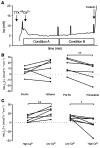Activation of the calcium sensing receptor attenuates TRPV6-dependent intestinal calcium absorption
- PMID: 31013259
- PMCID: PMC6629117
- DOI: 10.1172/jci.insight.128013
Activation of the calcium sensing receptor attenuates TRPV6-dependent intestinal calcium absorption
Abstract
Plasma calcium (Ca2+) is maintained by amending the release of parathyroid hormone and through direct effects of the Ca2+ sensing receptor (CaSR) in the renal tubule. Combined, these mechanisms alter intestinal Ca2+ absorption by modulating 1,25-dihydroxy vitamin D3 production, bone resorption, and renal Ca2+ excretion. The CaSR is a therapeutic target in the treatment of secondary hyperparathyroidism and hypocalcemia a common complication of calcimimetic therapy. The CaSR is also expressed in intestinal epithelium, however, a direct role in regulating local intestinal Ca2+ absorption is unknown. Chronic CaSR activation decreased expression of genes involved in Ca2+ absorption. In Ussing chambers, increasing extracellular Ca2+ or basolateral application of the calcimimetic cinacalcet decreased net Ca2+ absorption across intestinal preparations acutely. Conversely, Ca2+ absorption increased with decreasing extracellular Ca2+ concentration. These responses were absent in mice expressing a non-functional TRPV6, TRPV6D541A. Cinacalcet also attenuated Ca2+ fluxes through TRPV6 in Xenopus oocytes when co-expressed with the CaSR. Moreover, the phospholipase C inhibitor, U73122, prevented cinacalcet-mediated inhibition of Ca2+ flux. These results reveal a regulatory pathway whereby activation of the CaSR in the basolateral membrane of the intestine directly attenuates local Ca2+ absorption via TRPV6 to prevent hypercalcemia and help explain how calcimimetics induce hypocalcemia.
Keywords: Calcium; Calcium channels; Gastroenterology; Nephrology.
Conflict of interest statement
Figures







Similar articles
-
Juxtaglomerular cell CaSR stimulation decreases renin release via activation of the PLC/IP(3) pathway and the ryanodine receptor.Am J Physiol Renal Physiol. 2013 Feb 1;304(3):F248-56. doi: 10.1152/ajprenal.00451.2012. Epub 2012 Dec 5. Am J Physiol Renal Physiol. 2013. PMID: 23220722 Free PMC article.
-
Calcium-sensing receptor regulates intestinal dipeptide absorption via Ca2+ signaling and IKCa activation.Physiol Rep. 2020 Jan;8(1):e14337. doi: 10.14814/phy2.14337. Physiol Rep. 2020. PMID: 31960592 Free PMC article.
-
Functional TRPV6 channels are crucial for transepithelial Ca2+ absorption.Am J Physiol Gastrointest Liver Physiol. 2012 Oct;303(7):G879-85. doi: 10.1152/ajpgi.00089.2012. Epub 2012 Aug 9. Am J Physiol Gastrointest Liver Physiol. 2012. PMID: 22878123
-
Calcimimetic and calcilytic drugs for treating bone and mineral-related disorders.Best Pract Res Clin Endocrinol Metab. 2013 Jun;27(3):373-84. doi: 10.1016/j.beem.2013.02.008. Epub 2013 Mar 27. Best Pract Res Clin Endocrinol Metab. 2013. PMID: 23856266 Review.
-
Recent updates on the calcium-sensing receptor as a drug target.Curr Med Chem. 2008;15(2):178-86. doi: 10.2174/092986708783330601. Curr Med Chem. 2008. PMID: 18220773 Review.
Cited by
-
Mucosal expression of Ca and P transporters and claudins in the small intestine of broilers is altered by dietary Ca:P in a limestone particle size dependent manner.PLoS One. 2022 Sep 1;17(9):e0273852. doi: 10.1371/journal.pone.0273852. eCollection 2022. PLoS One. 2022. PMID: 36048795 Free PMC article.
-
Structure and function of the calcium-selective TRP channel TRPV6.J Physiol. 2021 May;599(10):2673-2697. doi: 10.1113/JP279024. Epub 2020 Mar 13. J Physiol. 2021. PMID: 32073143 Free PMC article. Review.
-
International Union of Basic and Clinical Pharmacology. CVIII. Calcium-Sensing Receptor Nomenclature, Pharmacology, and Function.Pharmacol Rev. 2020 Jul;72(3):558-604. doi: 10.1124/pr.119.018531. Pharmacol Rev. 2020. PMID: 32467152 Free PMC article. Review.
-
Regulation of 1 and 24 hydroxylation of vitamin D metabolites in the proximal tubule.Exp Biol Med (Maywood). 2022 Jul;247(13):1103-1111. doi: 10.1177/15353702221091982. Epub 2022 Apr 28. Exp Biol Med (Maywood). 2022. PMID: 35482362 Free PMC article. Review.
-
Recombinant human parathyroid hormone (1-84) is effective in CASR-associated hypoparathyroidism.Eur J Endocrinol. 2020 Dec;183(6):K13-K21. doi: 10.1530/EJE-20-0710. Eur J Endocrinol. 2020. PMID: 33112267 Free PMC article.
References
-
- Toka HR, Pollak MR, Houillier P. Calcium sensing in the renal tubule. Physiology (Bethesda) 2015;30(4):317–326. - PubMed
Publication types
MeSH terms
Substances
LinkOut - more resources
Full Text Sources
Molecular Biology Databases
Research Materials
Miscellaneous

